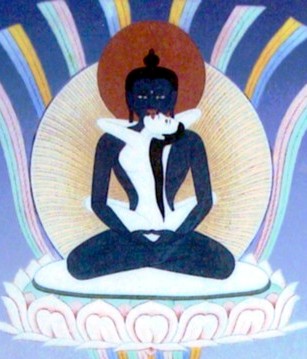Buddha Samantabhadra
Jump to navigation
Jump to search

Samantabhadra (Skt.; Tib. ཀུན་ཏུ་བཟང་པོ་, Kuntu Zangpo, Wyl. kun tu bzang po) — in the Dzogchen teachings, our true nature, that state of the Ground, is given the name the 'Primordial Buddha'. Sogyal Rinpoche writes, "[Kuntuzangpo] represents the absolute, naked, sky-like primordial purity of the nature of our mind".[1]
He is depicted as a buddha, sky-blue in colour, sitting in the vast expanse of space, and encircled by an aura of rainbow light. He is completely naked, meaning unstained by any trace of concept. His name, Kuntuzangpo in Tibetan, Samantabhadra in Sanskrit, means ‘always good', ‘always well’ or ‘unchanging goodness.’ What this signifies is that unchanging goodness, or fundamental goodness, is our ultimate nature.
The Five Aspects of Samantabhadra
- Samantabhadra as teacher (Tönpa Kuntuzangpo) means that all buddhas, while residing in the forms of the sambhogakaya and the dharmakaya in Akanishta, promote the welfare [of all sentient beings] through sending forth [countless] emanations to all the distinct realms of those to be guided.
- Samantabhadra as ground is the dharmata of all phenomena—suchness. This is [also] called “Samantabhadra as nature.”
- Samantabhadra as adornment (Gyen Kuntuzangpo) refers to the appearances of all phenomena, which are self-arising as the play of the bearers of the nature [of phenomena]. This consists of [all] that is completely pure, in that its nature is illusory.
- Samantabhadra as awareness [rigpa] (Rigpa Kuntuzangpo) is self-arising wisdom, the sugata heart.
- Samantabhadra as realization (Tokpa Kuntuzangpo) is the fundamental basic nature. Through realizing it well, the eyes of freedom are found. This is [also] called “Samantabhadra as the path.” (Lam Kuntuzangpo)[2]
Teachings About Kuntuzangpo
- Dzongsar Khyentse Rinpoche, Rigpa London, 8 February 1992
- Sogyal Rinpoche, Berlin Centre, 4 June 2011
Further Reading
- The Dzogchen Ponlop Rinpoche, Penetrating Wisdom: The Aspiration of Samantabhadra, (Ithaca: Snow Lion Publications, 2006), pages 33-37.
- Karl Brunnhölzl, A Lullaby to Awaken the Heart: The Aspiration Prayer of Samantabhadra and Its Tibetan Commentaries (Sommerville: Wisdom Publications, 2018), pages 3-36.
Notes
- ↑ The Tibetan Book of Living and Dying, page 106.
- ↑ Based on Longchenpa's Treasure Trove of Scriptures, his autocommentary on the Treasury of Dharmadhatu, translated in A Lullaby to Awaken the Heart, page 26.